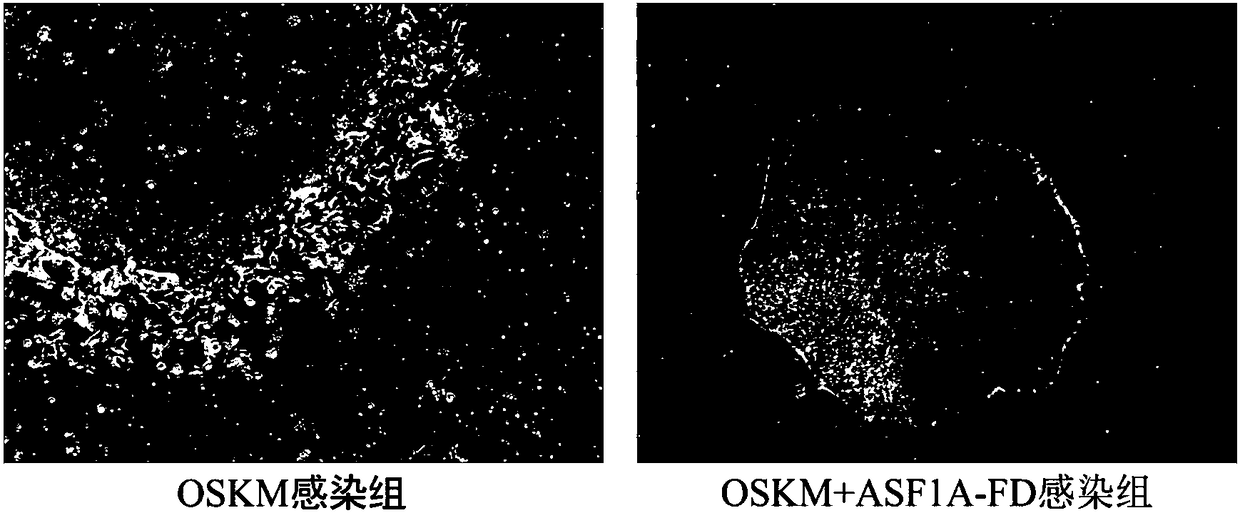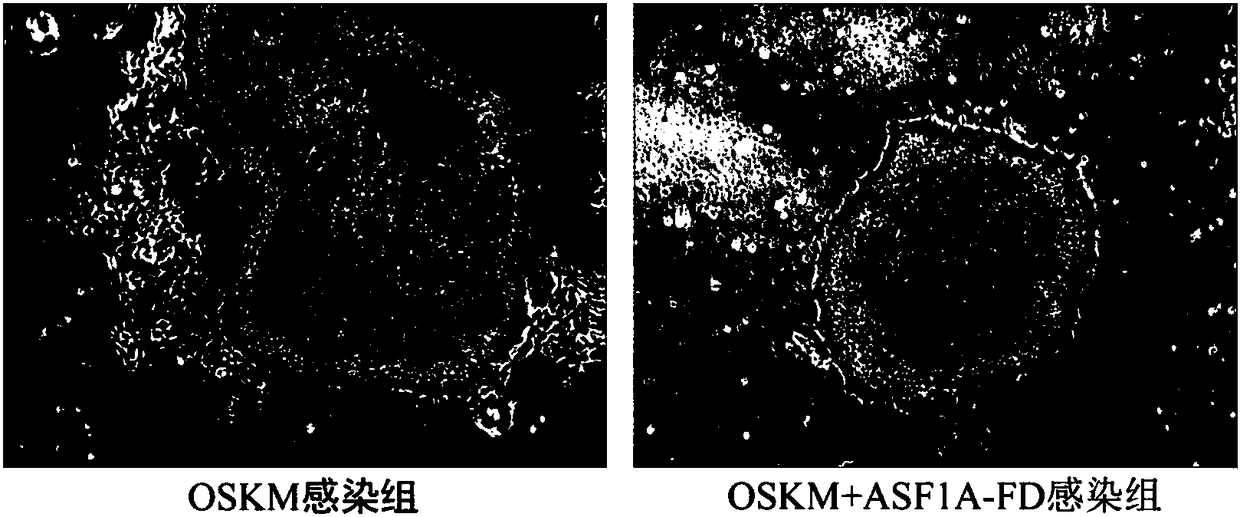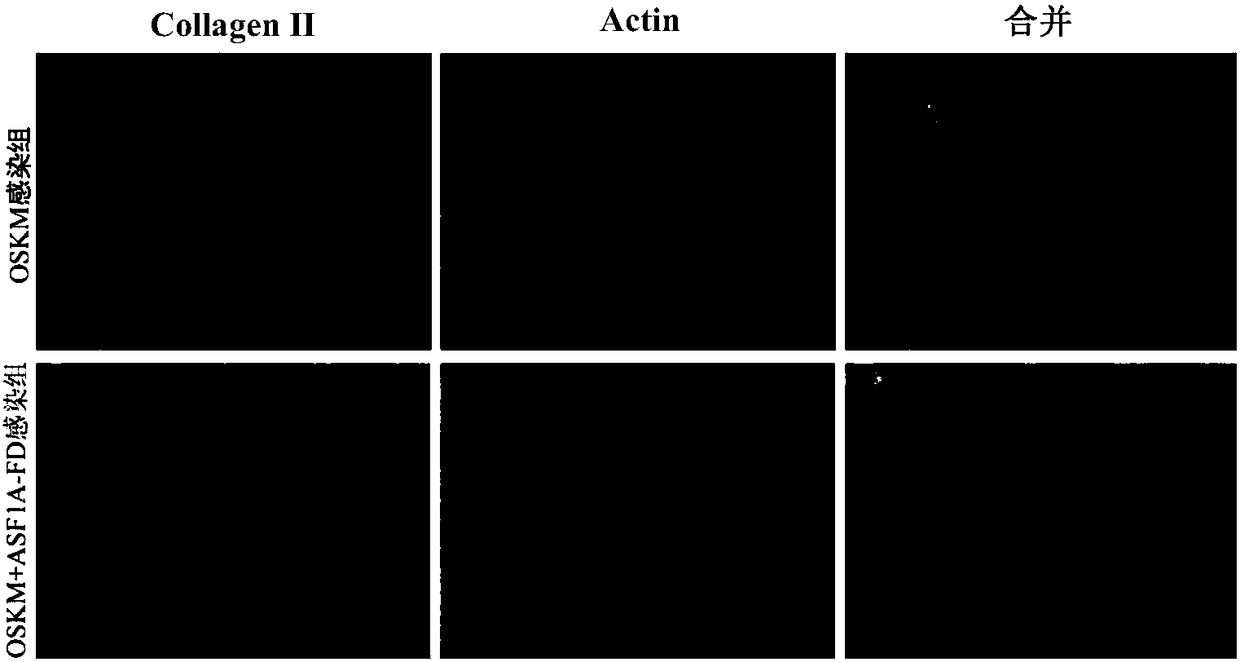Method for inducing reprogramming of skin fibroblast and application thereof
A fibroblast and reprogramming technology, applied in the field of cells, can solve the problems of low reprogramming efficiency and poor stability of iPS cells
- Summary
- Abstract
- Description
- Claims
- Application Information
AI Technical Summary
Problems solved by technology
Method used
Image
Examples
preparation example Construction
[0064] In the method for preparing iPS cells described above, transcription factors and ASF1A-FD genes are introduced into skin fibroblasts. Wherein the transcription factors include Oct3 / 4, Sox2, Klf4 and c-Myc, and the ASF1A-FD gene includes the gene encoding the 1st amino acid to the 154th amino acid of the ASF1A protein. The experimental results show that the introduction of ASF1A-FD gene and OSKM four genes into skin fibroblasts can greatly improve the reprogramming efficiency of human iPS cells, and its reprogramming efficiency is 13.8 times that of the traditional OSKM four gene introduction method, and the obtained iPS The cells can maintain pluripotency for a long time in in vitro culture and passage, which solves the defects of low reprogramming efficiency and easy differentiation during the passage of traditional iPS reprogramming methods.
[0065] In summary, the above method for preparing iPS cells, introducing transcription factors and ASF1A-FD genes into skin fi...
Embodiment 1
[0100] Construction of Retroviral Expression Vector pMXs-ASF1A-FD Containing ASF1A Functional Domain
[0101] 1. Selection of ASF1A functional domain
[0102] For the functional domain of ASF1A protein selected in this example, refer to GenBank: CAG33628.1 amino acid No. 1 to amino acid No. 154, labeled as ASF1A-FD.
[0103] 2. Construction of retroviral expression vector containing ASF1A-FD
[0104] The gene encoding ASF1A-FD is artificially synthesized, and the nucleotide sequence of the ASF1A-FD gene is shown in SEQ ID No.1. A BamH I restriction enzyme site CGGATCCG (shown in SEQ ID No.2) is added at the 5' end, and an XhoI restriction enzyme site CCTCGAGG (shown in SEQ ID No.3) is added at the 3' end. The gene fragment synthesized above was cloned into the retroviral vector pMXs (Cell Biolabs, RTV-010) by BamH I and XhoI double digestion, and the constructed retroviral expression vector pMXs-ASF1A-FD was double digested by BamH I and XhoI. Enzyme digestion for identific...
Embodiment 2
[0106] Preparation of retrovirus
[0107] Select PLAT-A cells as retrovirus packaging cells, which are obtained from human embryonic kidney HEK293 cells by stably transfecting gag, pol and env genes. HEK293 cells transfected with gag, pol and env genes can tolerate a single plasmid Transfection enables rapid production of retroviruses. ASF1A-FD retroviruses and Oct3 / 4, Sox2, Klf4, and c-MYC retroviruses were packaged and prepared using this system, and Oct3 / 4, Sox2, Klf4, and c-MYC retrovirus expression plasmids were all purchased from Addgene (Cat. No. 17217, 17218, 17219, 17220 respectively). The ASF1A-FD retrovirus expression plasmid was prepared according to the method in Example 1.
[0108] The detailed experimental steps of retrovirus preparation are as follows:
[0109] (1) Day1: Inoculate Plat-A cells into a 10cm culture dish, 5×10 6 pcs / dish, 6 dishes in total, at 37°C, 5% CO 2 Incubate overnight in an incubator.
[0110] (2) Day2: 2 hours before plasmid transfe...
PUM
 Login to View More
Login to View More Abstract
Description
Claims
Application Information
 Login to View More
Login to View More - Generate Ideas
- Intellectual Property
- Life Sciences
- Materials
- Tech Scout
- Unparalleled Data Quality
- Higher Quality Content
- 60% Fewer Hallucinations
Browse by: Latest US Patents, China's latest patents, Technical Efficacy Thesaurus, Application Domain, Technology Topic, Popular Technical Reports.
© 2025 PatSnap. All rights reserved.Legal|Privacy policy|Modern Slavery Act Transparency Statement|Sitemap|About US| Contact US: help@patsnap.com



